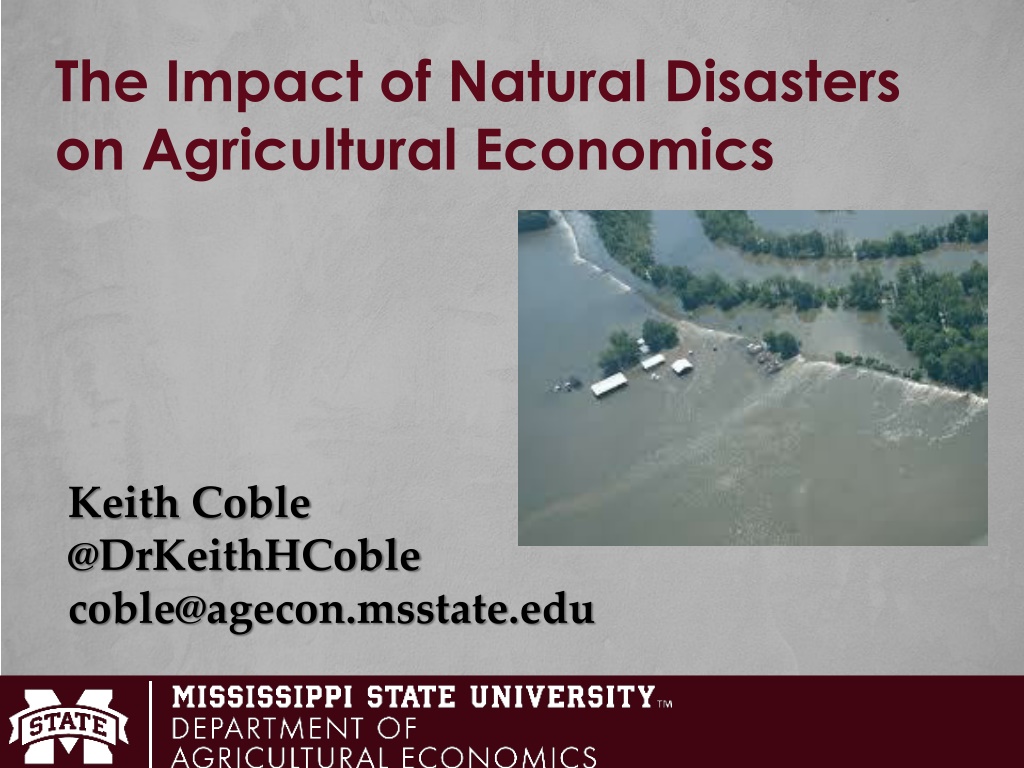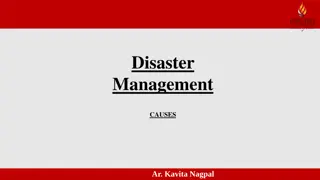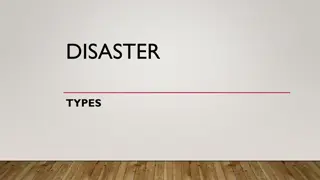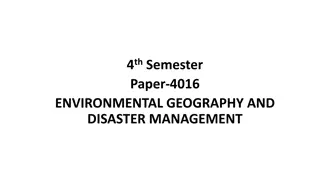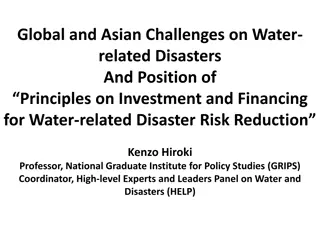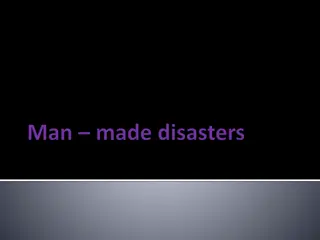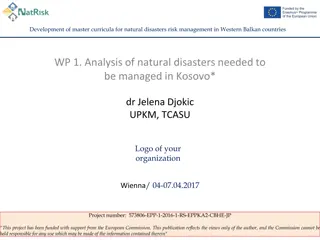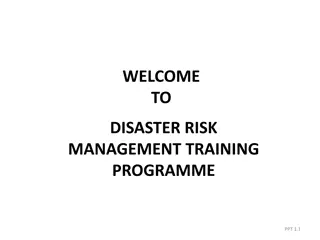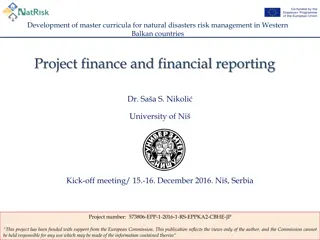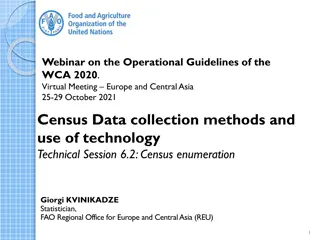Understanding Agricultural Risk Management in the Face of Natural Disasters
Exploring the impact of natural disasters on agricultural economics, this content delves into the challenges faced by farmers and the approaches available for managing risks. From analyzing the Billion-Dollar Disasters in the US to discussing private and public risk management provisions, the content highlights the complexity of agricultural risk assessment and offers insights into risk avoidance, loss prevention, retention, and transfer strategies. It emphasizes the unique nature of agricultural risk compared to other risks and presents the Agricultural Crop Risk Spectrum, showcasing different types of risks farmers encounter in their operations.
Download Presentation

Please find below an Image/Link to download the presentation.
The content on the website is provided AS IS for your information and personal use only. It may not be sold, licensed, or shared on other websites without obtaining consent from the author. Download presentation by click this link. If you encounter any issues during the download, it is possible that the publisher has removed the file from their server.
E N D
Presentation Transcript
The Impact of Natural Disasters on Agricultural Economics Keith Coble @DrKeithHCoble coble@agecon.msstate.edu
United States Billion-Dollar Disasters By Year (CPI-Adjusted) 350 300 250 200 318.9 150 226.1 100 130.9 50 92.8 79.1 78.7 76.1 66.553.5 50.5 45 44.432.3 37.5 13.726.818.112.531.520.311.71719.531.7 29.3 25.619.124.5 19.8 15.6 10.616.1 14.1 15.6 2.613.95.40 2.94.4 0 1980 1982 1984 1986 1988 1990 1992 1994 1996 1998 2000 2002 2004 2006 2008 2010 2012 2014 2016 2018 NOAA National Centers for Environmental Information (NCEI) U.S. Billion- Dollar Weather and Climate Disasters (2020). https://www.ncdc.noaa.gov/billions/
Private and Public Risk Management Provisions The revolutionary idea that defines the boundary between modern times and the past is the mastery of risk .Risk management guides us over the vast range of decision making from allocating wealth to safeguarding public health, from waging a war to planning a family, from paying insurance premiums to wearing a seatbelt; from planting corn to marketing cornflakes. Peter Bernstein in Against the Gods: The Remarkable Story of Risk
Approaches to Risk Management? Risk avoidance don t drive Loss prevention Wear your seat belt Risk retention Don t pay for insurance on an old car Risk transfer insurance or futures markets
Approaches to Farm Risk Management? Risk avoidance Don t farm Loss prevention Develop on- farm water storage Risk retention Personal saving Risk transfer insurance or futures markets
Agricultural Risk is Difficult to Assess Relative to Other Risks Risk is a function of: Weather over entire season Management decisions Variety Soils Production system Markets
9 Agricultural Crop Risk Spectrum of Risk Independence Independent risk Futures Markets Positively Correlated risk Insurance Hail Yield Revenue Price
Public versus Private Private Innovation Can tap into world reinsurance market Avoids moral hazards and adverse selection Public Subsidized Can tap into U.S. treasury Rarely can solve the moral hazard and adverse selection problems
Deceiving ourselves about ag risk It's easier to fool people than to convince them that they have been fooled. Mark Twain Why, sometimes I've believed as many as six impossible things before breakfast. - Alice in Wonderland. The creature we study in economics is similar to Mr. Spock from Star Trek The world I study is full of people more like Homer Simpson Robert Thaler
Cost and Benefit of Conservation and Disaster Prevention Short Run versus Long Run Discount rates and risk aversion Uncertainty Personal versus social benefits Reversibility
Soil Health as an Example Long term vs Short-term Planning Current soil health policy may crowd-out privately optimal behavior. Optimal policy depends on whether society and landowners value the future differently. Farmers probably don t know enough their own soil health. We still do not know much about how soil health evolves over time in response to production practices.
Expected Soybean Indemnity Based on 6 12 & 24 Years of History 40.000 35.000 30.000 25.000 20.000 15.000 10.000 5.000 0.000 161 101 106 111 116 121 126 131 136 141 146 151 156 166 171 176 66 1 6 11 16 21 26 31 36 41 46 51 56 61 71 76 81 86 91 96 TRUE 24 Years 12 years 6 Years
Why good loss experience? Good weather, risk pool, production systems, or better crop insurance program RMA Aggregate Loss Ratio 1980-2018 3 2.5 1980-1995 Avg. =1.48 Loss Ratio 2 1996-2018 Avg. = 0.83 1.5 1 0.5 0 Year 96-17 AVG Loss Ratio 80-95 AVG Expon. (Loss Ratio)
Ex Ante Indemnification 1. Ex ante insurance institutionalizes premiums and indemnity structures for insurable risks. More time is available to define and implement the program than an ex post program. A standing program is costly and, if premiums are charged, government costs are reduced. However, if producers are unwilling to pay for insurance, then government objectives are thwarted - generally, the low willingness to pay for insurance is a function of either low probabilities of occurrence or low economic costs of an occurrence, or both. 2. 3.
Ex Post Indemnification 1. do not require significant a priori institutional infrastructure or producer enrollment. Avoids the creation of institutions and program costs for a low probability event. the hurried nature of ex post indemnification and the tendency for each event to differ makes it difficult to either efficiently or equably indemnify rare, but often costly, events. a completely ad hoc program also precludes incentive structures to induce preventive measures. A related issue is the demand for protection for extremely low probability risks. - decision makers often make large errors in subjective assessments - insurance demand? - penalties and incentive structures (Bonus/Malus systems)? 2. 3. 4. 5.
Ex Ante Indemnification Manageable risks with high probability of occurrence and available effective management strategies are seldom deemed insurable. Insuring a risk that has effective management remedies would likely be fraught with moral hazard issues as insurance would provide a strong incentive to shirk good management In some instances producers may require education, training or decision aids which the government may support or develop. Group management or spatial eradication programs tend to have high initial costs but strong long-run benefits/cost ratios. They also have potential for free-rider problems.
The Future Likely to face more severe events Can government incentivize mitigation rather than disincentivize it? Can public and private complement? Technology Rainfall maps and basis risk Ground truth, soil mapping, etc.
